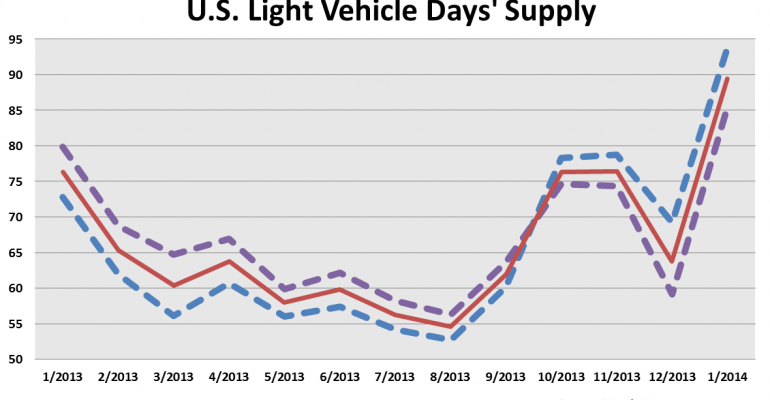U.S. light-vehicle inventory rose to a 9-year high for the month of January and is well above what the industry needs to meet current demand.
How serious the glut is, as it pertains to possible cuts to production plans, depends on how much sales rebound from January’s weather-dampened results and whether fleet deliveries pick up.
Inventory totaled 3.61 million units at the end of January, 13.7% above year-ago and the highest for the month since 3.89 million in 2005. At the time in 2005, sales were running close to a 17 million-unit annual pace, based on the trailing 12-month sales total. Trailing12-month sales totaled 15.5 million through January 2014 and have been stuck at that level for three months.
Sales declined from the same year-ago month in January for the first time since 2010, but volume likely would have increased if not for bad weather throughout much of the eastern half of the U.S.
Thus, much of the excess inventory could be alleviated by a rebound from January’s slowdown. However, at this point the weather-related loss is hard to estimate.
Days’ supply increased to 89 on Jan. 31 from 64 in December. A large December-to-January increase is normal, but a 25-day jump is about 10 days higher than average. The unnaturally high gains across all segment groups is either proof the weather had a large impact on January sales or that North American production and import shipments have been excessive.
Additionally, indications are that fleet penetration this year will decline, because manufacturers are getting less aggressive about marketing to rental companies. Data from automakers and third-party sources indicate fleet share of industry sales has been in decline for the last few months.
Conversely, with fleet-mix having been down for several months, there still could be a temporary surge in volume from pent-up demand for vehicles in that sector, which would pare inventory.
Furthermore, Ford says the weather delayed some fleet shipments, and that could have been the case for other automakers.
WardsAuto estimates inventory is about 300,000 to 400,000 units higher than the optimum level to meet current market demand.
Part of the excess appears related to model changeovers and, in one case, the end of production for a high-volume car.
General Motors last month began the changeover at its Arlington, TX, plant to redesigned fullsize SUVs off the next-generation GMT900 platform, or its K2XX products.
Inventory of GM’s SUVs ended January at a huge 141 days’ supply, which should tide over dealers as production of the Chevrolet and GMC models ramp up during the first quarter. The Cadillac models, Escalade and ESV, start in April.
Also, Chrysler’s Dodge Avenger entered February with a 220 days’ supply. But that likely is related to a production slowdown at the manufacturer’s Sterling Heights, MI, plant.
This month, Sterling Heights permanently ends production of the Avenger and tools for the new 200 to be built off the Fiat-based C/D-Evo platform beginning in March. The inflated stock will give dealers some padding for midsize cars during the production downtime. The Dodge Dart’s 131 days’ supply also could help, depending on how many potential buyers of the older 200/Avenger midsize cars are willing to buy a slightly smaller vehicle.
Still, there are some troubling pockets, mainly in cars.
Days’ supply for small cars totaled 90 on Jan. 31, compared with 75 a year ago, and days’ supply for midsize cars soared to 99 from same-month 2013’s 68.
Besides Fiat-Chrysler, other automakers with significantly higher small- and midsize-car inventory include Ford, Honda, Mazda and Volkswagen. GM, Hyundai and Toyota are tipping the scales on midsize cars.





